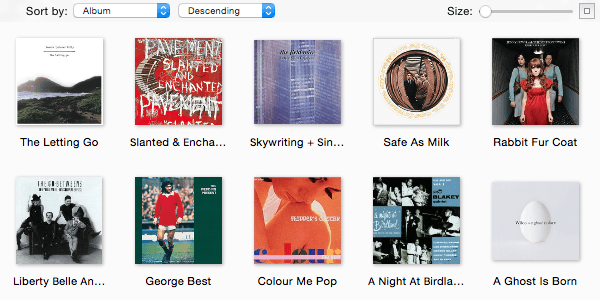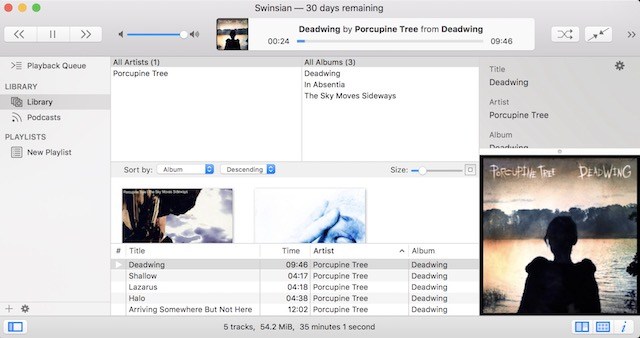
- #Is Swinsian Still Supported Update The Cue#
- #Is Swinsian Still Supported Software Made Of#
- #Is Swinsian Still Supported Free And Open#
Go to the Title link to explore more about Swinsian. There are also variable sample rates for songs. You can switch the band equalizer to match your system settings. The music plays at the highest quality through Swinsian. There is no loss in audio files. The platform supports audio extensions like MP3, MusePack, WAV, WMA, AC3, etc.
Is Swinsian Still Supported Free And Open
What file formats are supported Most popular audio formats are supported: MP3, AAC, ALAC, WAV, FLAC, Ogg Vorbis, AIFF, Opus, AC3, APEWavPack, MusePack, DSF, and WMA. Unfortunately, as of yet, the Dark Mode is not available on any smartphone.Swinsian can be used on any Mac running macOS 10.8 or later. VLC is a free and open source cross-platform multimedia player and framework.Swinsian is a sophisticated music player for macOS with wide format support. Productivity Social Video Audio and Music. Sync iTunes Libraries ITunes like user interface. Folder watching makes the process of adding new files as automatic as possible.

Is Swinsian Still Supported Software Made Of
Floola is a freeware application to efficiently manage your iPod or your Motorola mobile phone any model supporting iTunes except iPhone and iPod touch.It's a standalone application that can be run directly from your iPod. JRiver Media Center is a multimedia application that allows the user to play and organize various types of media on a computer running Windows. Not only does it play various music and video files, it also has features such as CD burning, recording, and conversion to other file formats. Tomahawk gives you to access to all of your favorite music in one powerful media player.JetAudio is integrated, multimedia software made of a single compact rack. As it is written in Python, writing new plug-ins is really easy.
Free Windows.Use these steps on your Mac to combine photos and videos from separate Photos libraries into one library.To combine Photos libraries, open the source library and export the photos and videos that you want to keep. Media Jukebox is an all-in-one media player, music collection organizer, iPod connector and music store with extreme tagging techniques.This music player can pretty much do it all. Featuring a solid core set of functions, musikCube is very lightweight and fast, with an interface that will be immediately familiar to anyone who's used an iTunes or Amarok 1.
Open the destination librarythen drag the folder that contains your exported items into the main area that shows your other photos and videos. This gives you flexibility for later editing, but recreating your edits might take substantial work. Unmodified originals don't show any edits that you made when they were in the source library. The advantage is that you don't have to recreate any edits however, these files become the destination library's originals.This means that you can't revert to their earliest pre-import version. Edited versions retain their edits when you import them. Open the source librarythen decide whether you want to export your files as unmodified originals or edited versions.
Combine libraries in Photos Use these steps on your Mac to combine photos and videos from separate Photos libraries into one library.Choose a photo library Here's how to open one of the multiple photo libraries that you might have on your Mac or on a connected external drive: Press and hold the Option key as you open the Photos app. By default, photo libraries are stored in your Pictures folder.If you can't find the library, follow the steps to choose a library the path to the selected library's location appears in the Choose Library window.Next, move the source library to the Trash. If you're sure that you've exported all of the photos and videos that you want to keep from the source library, you can delete it to save disk space on your Mac.First, open the Finder and find the source library that you want to delete. If you created subfolders when you exported the items and you want to create an Album for each subfolder, follow these steps. The videos are sorted based on the date you exported them from the source library.
See the cmake-buildsystem 7 manual for more on defining buildsystem properties. See the cmake-generator-expressions 7 manual for available expressions. Export photos and videos from the source library Open the source librarythen decide whether you want to export your files as unmodified originals or edited versions.MODULE libraries are plugins that are not linked into other targets but may be loaded dynamically at runtime using dlopen-like functionality.By default the library file will be created in the build tree directory corresponding to the source tree directory in which the command was invoked. Combine libraries in PhotosPhotos uses this library until you open a different one using the same steps.
An interface library created with the above signature has no source files itself and is not included as a target in the generated buildsystem. However, it may have properties set on it and it may be installed and exported. Object libraries may contain only sources that compile, header files, and other files that would not affect linking of a normal library e.Creates an Interface Library. An object library compiles source files but does not archive or link their object files into a library.

Is Swinsian Still Supported Update The Cue
Swinsian can import libraries from iTunes and from the new Music app on Catalina.Playlists and track metadata like play counts will be copied to Swinsian.On Catalina iTunes has been replaced by the new Music application. To prevent other applications playing sounds on the same device you may wish to change the audio output device in Swinsian to be different from the system wide output device that is set in the System Preferences. Check that 'Automatically adjust device sample rate' is enabled in the Swinsian preferences. For example a track with the genre 'Rock, Pop' will be shown under both 'Rock' and 'Pop' in the browser.Make sure that both the system wide and Swinsian volume settings are set to maximum. For albums ripped as single files with cue sheets Swinsian will attempt to update the cue file or embedded cue sheet if found.Turn on the 'Recognise multiple genre tags per track' option in the Tags tab of the Swinsian preferences and Swinsian will show tracks under more than one genre if the genre tag value is a list of comma separated values. You can customise this behaviour in the preferences if you would prefer to leave the files unchanged.
Devices running iOS are only partially supported copying tracks from them onto your computer may be possible for some devices, but changing the library on the device is not possible.This is due to encryption of the database file checksum by Apple. If you have smart playlists that you wish to import you will need to export the Music library as an xml file and use the 'Import iTunes Library…' command described below.When importing a Music library Swinsian will not make a new copy of the audio files so it's advisable to disable the 'Keep Music Media folder organised' option in the 'Files' section of the Music preferences so that files aren't moved once they have been imported into the Swinsian library.It's also a good idea to disable the 'Keep iTunes Media folder organised' option in iTunes so that it won't move or rename any files once they have been imported into the Swinsian library.If you use an iOS device you will still need to use iTunes or Music to sync music to the device. The 'Import Music App Library' command does not support importing smart playlist rules. Either click the import button in the welcome window when you first run Swinsian or use the 'Import Music App Library' command in the File menu.
This only needs to be done once.No, Swinsian does not currently support burning or ripping CDs. Classic style iPods need to be set to allow disk use before Swinsian can read them. The Swinsian BlogAdd at least one track using iTunes before adding music with Swinsian. Yes, Swinsian supports copying music files from iPods to the local library, or directly from one connected iPod to another connected iPod as long as the target device can be written to, see above.Some newer iPod models need to be initialised by iTunes before Swinsian can add music to them.
Swinsian licenses are per user rather than per computer, so you can use the same license on as many computers as you own.


 0 kommentar(er)
0 kommentar(er)
